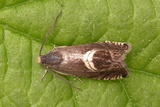Grapholita discretana Wocke, 1861 Species
Last modified: Nov. 25, 2025, 2:05 p.m.
A very rare and local species in Belgium.
Details
- Classification
- Family: Tortricidae > Subfamily: Olethreutinae > Tribus: Grapholitini > Genus: Grapholita > Species: Grapholita discretana
- Vernacular names
- V-haakspiegelmot (NL), Hopfengeschlingwickler (DE)
- Synonyms
- Grapholita dorsana (Hübner, 1801), nec (Fabricius, 1787)
- First mention in Belgium
- De Sélys-Longchamps E. 1844. Énumération des insectes Lépidoptères de la Belgique. — Mémoires de la Société royale des Sciences de Liége 2: 1–35. On page 21.
- Status
-
Native
Distribution
Imago
Wingspan 13–18 mm. Forewing brown, paler in basal area, with indistinct brown strigulae, postmedian strigulae white, speculum brown ochreous with inner spots, refractive lines distinct, distal part of wing sprinkled ochreous or pale rust. Dorsal patch creamy white consisting of two slightly curved lines; Cilia brownish or creamy brown. Hindwing brown, cilia creamy brown or whitish.
Bionomics
The larva lives and hibernates in the stems of the host plant. The caterpillar-covered stems are usually less than 1 m above the ground. Signs of infestation are not particularly noticeable, apart from (sometimes) an inconspicuous hole with frass, there is little externally visible of the presence of the caterpillar and the affected shoots do not wilt.
The adults come very rarely to light.
Flight periods
The adults fly from early May towards late June in a single generation a year.
Habitat
It inhabits overgrown, hop-covered areas.














